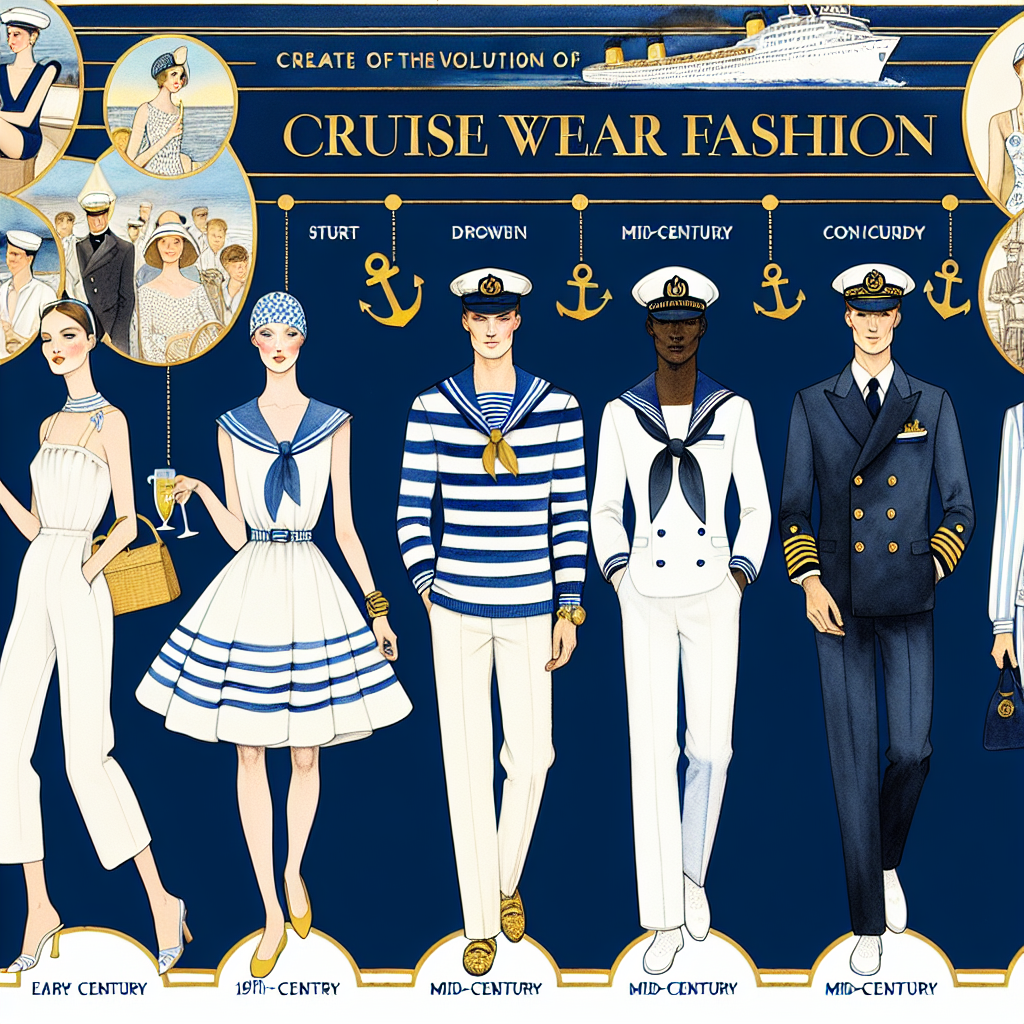
Step aboard the fashion time machine as we embark on a stylish voyage through the history of cruise wear! From the classic sailor stripes of the early 20th century to the glamorous resort wear of the modern day, this article takes you on a captivating journey, showcasing the evolution of nautical fashion on the high seas. So grab your captain’s hat and prepare to set sail into the fascinating world of cruise wear through the years.
The Origins of Nautical Fashion
Nautical fashion has a rich history, dating back to the 19th century when navy clothing influenced mainstream fashion. The robust and functional clothing worn by sailors and naval officers made a lasting impression on the fashion world. The classic navy blue and white color palette, as well as elements like anchor motifs and stripes, became popular among fashion enthusiasts.
Influence of the 19th Century Navy Clothing
The navy clothing of the 19th century played a significant role in shaping nautical fashion. The durable and practical design of naval uniforms, tailored to withstand the harsh conditions at sea, caught the attention of fashion designers and stylists. The wide-leg trousers, double-breasted jackets, and sailor hats incorporated into mainstream fashion, giving birth to the classic sailor aesthetic that remains popular to this day.
Introduction of the Sailor Suit
One iconic aspect of nautical fashion is the sailor suit. Introduced in the late 19th century, the sailor suit originally made its mark as a children’s outfit. This charming ensemble featured a short-sleeved blouse with a sailor collar, paired with wide-leg trousers and a cap. The sailor suit symbolized youthful innocence and adventure, while also evoking a sense of maritime tradition.
The Symbolism of Stripes in Nautical Fashion
Stripes have always been an integral part of nautical fashion. In the 19th century, sailors commonly wore striped shirts to distinguish them from other professions. These horizontal stripes, often in navy blue and white, were not only practical but also became a symbol of nautical fashion. The stripes represented the waves of the sea and added a touch of authenticity to maritime-inspired outfits.
1920s Cruise Wear
The 1920s witnessed a rise in luxury cruise travel, which significantly influenced fashion trends. As passengers embarked on glamorous ocean voyages, cruise wear became an essential aspect of their travel wardrobe. During this era, the concept of leisurewear emerged, revolutionizing the way people dressed during their vacations. Instead of the formal and restrictive clothing of the past, cruise wear became more relaxed, comfortable, and casual.

Rise of Luxury Cruise Travel
The increasing popularity of luxury cruise travel in the 1920s propelled the demand for fashionable cruise wear. The elite passengers aboard ocean liners sought to display their wealth and social status through their attire. This led to the creation of elegant and sophisticated cruise wear that exuded luxury and refinement.
Introduction of Leisurewear
Leisurewear characterized the fashion of the 1920s cruise scene. Women embraced loose-fitting and comfortable garments like wide-leg trousers, loose blouses, sleeveless dresses, and beach pajamas. These relaxed silhouettes allowed for greater freedom of movement, catering to the desire for leisure and pleasure during cruise vacations.
The Influence of Coco Chanel
Coco Chanel, the influential fashion designer of the 1920s, played a pivotal role in shaping cruise wear. She introduced innovative designs that fused elegance with practicality, revolutionizing women’s fashion during this era. Chanel’s creations, such as the iconic striped jersey tops and wide-leg trousers, inspired by naval uniforms, became integral to the nautical fashion of the time.
1930s and 1940s: A Time for Elegance and Simplicity
The tumultuous 1930s and 1940s marked a shift in cruise fashion. The impact of the Great Depression and World War II resulted in evolving trends and more simplistic styles. People sought comfort and functionality in their clothing, embracing practicality while still maintaining a sense of elegance.
Impact of the Great Depression
The economic challenges of the Great Depression had a profound effect on fashion. People had limited resources and had to make do with what they had. This led to a simplification of cruise wear, with more emphasis on versatile pieces that could be mixed and matched. Classic staples like tailored trousers, blouses, and lightweight cardigans became essential components of cruise outfits.

Evolving Trends and the Creation of ‘Boat Necklines’
The 1930s witnessed the emergence of boat necklines in nautical fashion. Also known as bateau necklines, these wide and horizontal necklines were inspired by the shape of boat hulls. They imparted an elegant and subtle touch to outfits, flattering the shoulders and framing the face. Boat necklines became popular in both casual and formal cruise wear.
Introduction of the Two-Piece Bathing Suit
In the 1940s, the two-piece bathing suit gained popularity, bringing a touch of playfulness to cruise fashion. The bikini, introduced by French designer Louis Réard in 1946, marked a significant shift in swimwear trends. While still showcasing modesty compared to modern bikinis, these two-piece swimsuits allowed a greater range of movement and emphasized a more active lifestyle.
1950s: An Era of Glamour and Class
The 1950s saw a surge of glamour and sophistication in cruise fashion. The post-war years brought a renewed sense of hope and joy, inspiring a celebratory approach to dressing. From the rise of bathing beauty culture to the creation of iconic nautical designs, this era embraced elegance and class.
Bathing Beauty Culture
The 1950s heralded the rise of bathing beauty culture, with beauty pageants and contests becoming immensely popular. In these events, women showcased their fashion sense and poise while donning stylish swimsuits. Nautical-inspired bathing suits with sailor collars, anchor motifs, and stripes became synonymous with the timeless beauty associated with this era.
Iconic Nautical Designs and Patterns
The 1950s witnessed the creation of iconic nautical designs that continue to inspire fashion today. Anchor motifs adorned dresses, blouses, and accessories, evoking a sense of maritime elegance. Stripes remained a staple, with navy blue and white combinations dominating cruise wear. These classic elements expressed a love for the sea and its timeless allure.

Sophisticated Cruise Wear by Hollywood Stars
Hollywood stars played a pivotal role in popularizing sophisticated cruise wear in the 1950s. Leading ladies like Audrey Hepburn and Grace Kelly became style icons, showcasing elegant and refined outfits in movies set aboard luxurious cruise ships. These stars influenced fashion trends and further elevated the status of nautical fashion as the epitome of glamour and class.
Cruise Fashion in the Swinging 60s and Cool 70s
The 1960s and 1970s brought a wave of changes to cruise fashion, reflecting the cultural shifts of these decades. From the emergence of the bikini to the influence of hippie fashion, this period witnessed the introduction of casual and relaxed cruise wear.
Emergence of the Bikini
The 1960s marked the emergence of the bikini as a staple in cruise fashion. With its daring design and body-revealing silhouettes, the bikini became a symbol of freedom and liberation. Women embraced this new swimwear style, showcasing their confidence and body positivity.
Hippie Influences on Cruise Fashion
The 1970s, influenced by the hippie movement, brought an infusion of bohemian elements to cruise wear. Flowing maxi dresses, fringed tops, and embroidered tunics became popular choices for those seeking a carefree and laid-back style. This era celebrated individuality and self-expression, with cruise fashion reflecting the cultural shift towards casualness and nonconformity.
Introduction of Casual and Relaxed Cruise Wear
The 1960s and 1970s marked a shift towards casual and relaxed cruise wear. Instead of the formal attire of previous decades, passengers sought comfort and ease in their vacation clothing. Lightweight fabrics, loose silhouettes, and breathable designs became the preferred choice for those embarking on cruise adventures.

Aquatic-Themed Patterns in the 1980s and 1990s
The 1980s and 1990s witnessed the resurgence of aquatic-themed patterns in nautical fashion. As retro trends made a comeback, designers and fashion enthusiasts rediscovered the allure of nautical stripes and maritime motifs.
Return of Nautical Stripes
In the 1980s and 1990s, nautical stripes made a strong comeback in cruise fashion. The bold and vibrant striped patterns evoked a sense of summer and the seaside, becoming a staple for both casual and formal cruise wear. Whether in traditional navy and white or a playful mix of colors, stripes captured the essence of nautical style.
Bathing Suits Become More Daring
The 1980s and 1990s also witnessed a trend towards more daring and bold bathing suits in cruise fashion. High-cut leg openings, plunging necklines, and low-back designs became increasingly popular. Swimsuits embraced a more risqué aesthetic, celebrating the freedom of expression and body confidence.
Influence of Surf Culture
Surf culture of the 1980s and 1990s left its mark on nautical fashion. The laid-back and carefree spirit associated with surfers influenced cruise wear, introducing elements like board shorts, rash guards, and neoprene materials. These sporty and functional styles embraced both fashion and functionality, catering to the growing demand for adventurous and active cruise experiences.
21st Century: Accessorizing Nautical Wear
In the 21st century, accessorizing plays a crucial role in nautical fashion. Whether through eclectic prints, ship wheel motifs, or seashell accessories, these embellishments add a touch of personal style and uniqueness to cruise wear.

Rise of Eclectic Prints
The 21st century brought a rise in eclectic prints that extended beyond traditional nautical stripes. Designs featuring sea creatures, tropical landscapes, and abstract patterns became popular choices for cruise wear. These prints infused a sense of whimsy and individuality into outfits, allowing individuals to express their personal style while embracing the nautical theme.
Incorporating Ship Wheel Motifs
Ship wheel motifs became a popular design element in accessorizing nautical wear. Whether in the form of jewelry, embroidered patches, or printed motifs, ship wheels added a touch of maritime charm and served as a symbol of adventure and exploration. These motifs celebrated the spirit of sea voyages and the allure of the open water.
Use of Seashells as Fashion Accessories
Seashells, once solely associated with beach vacations, became fashionable accessories in the 21st century. From seashell earrings to necklaces and even handbags adorned with shells, these natural elements added a touch of beachy elegance to nautical outfits. Seashells are now cherished as fashionable accents, reflecting a love for the sea and the unique beauty of the underwater world.
Impact of Climate and Regions on Cruise Fashion
The climate and regions of cruise destinations have a significant influence on the fashion choices of travelers. Whether it’s tropical and warm weather cruises, Mediterranean voyages, or cold weather excursions, different cruise experiences call for specific types of clothing.
Tropical and Warm Weather Cruise Wear
For tropical and warm weather cruises, lightweight and breathable fabrics are essential. Flowy maxi dresses, shorts, tank tops, and swimsuits are go-to options for staying cool and comfortable. Sun hats, sunglasses, and sunscreen are crucial accessories, ensuring protection from the intense tropical sun. Bright and vibrant colors reminiscent of sea and nature are popular choices for tropical cruise wear.
How Mediterranean Cruises Influenced Fashion
Mediterranean cruises have long been associated with a sense of elegance and sophistication. The region’s rich history and vibrant culture inspire fashion choices characterized by classic silhouettes, lightweight fabrics, and an emphasis on chic accessories. Sundresses, linen shirts, wide-brimmed hats, and strappy sandals are staples for exploring Mediterranean destinations in style.
Cold Weather Cruise Clothing
Cold weather cruises call for warm and cozy clothing options. Layering is key when facing the chill, with sweaters, scarves, and jackets serving both functional and fashionable purposes. Comfortable boots, gloves, and hats help protect against cold winds and snow. Classic colors like navy, gray, and black dominate cold weather cruise wear, creating a sophisticated and timeless look.
Dress Code and Rules of Modern Cruise Lines
Modern cruise lines often implement dress codes and guidelines for various occasions and areas of the ship. From formal nights to casual dress codes, understanding the rules helps passengers pack appropriately and feel comfortable during their voyage.
Formal Night on the Ship
Many cruise lines designate certain nights as formal nights, where passengers have the opportunity to dress up for elegant dining experiences and special events. Formal attire can range from cocktail dresses and suits to more extravagant evening gowns and tuxedos. These evenings allow passengers to embrace the glamour and sophistication reminiscent of classic nautical fashion.
Casual Dress Guidelines
Cruise lines also have designated casual dress guidelines for daytime and casual dining. Casual attire typically includes comfortable and relaxed clothing options such as sundresses, shorts, t-shirts, and sandals. It provides an opportunity for passengers to enjoy their vacation in a more laid-back and carefree fashion.
Themed Parties and Wardrobe Requirements
Many cruise lines organize themed parties or events, encouraging passengers to dress up according to the designated theme. From tropical nights to 80s disco parties, these events allow for playful and creative outfit choices. While not mandatory, participating in themed parties adds to the overall fun and enjoyment of the cruise experience.
The Future of Nautical Fashion
As the fashion industry evolves, so does nautical fashion. Several key factors will likely shape the future of cruise wear, including sustainability, technological influences, and trend forecasts.
Influence of Sustainability
In recent years, there has been a growing emphasis on sustainability in the fashion industry. This trend is likely to influence nautical fashion, with a focus on eco-friendly materials and ethical production practices. Innovative fabric technologies, such as recycled materials and organic fibers, may become more prevalent in cruise wear, allowing passengers to embrace nautical fashion while minimizing their environmental impact.
Technological Influences on Cruise Wear
Technological advancements continue to shape the fashion industry, and cruise wear is no exception. From smart fabrics that adjust to different climates to wearable tech accessories, technology has the potential to enhance the functionality and versatility of cruise clothing. This integration of fashion and technology may cater to the needs of modern travelers seeking convenience and practicality.
Trend Forecasts for Nautical Fashion
Looking ahead, trend forecasts suggest that nautical fashion will continue to be a timeless and beloved style. Classic elements such as navy blue and white stripes, anchor motifs, and ship wheel symbols are expected to persist as evergreen trends. However, there will also be an exploration of new color palettes, innovative prints, and unique accessories that push the boundaries of traditional nautical fashion.
In conclusion, nautical fashion has evolved throughout the years, influenced by naval clothing, luxury cruise travel, iconic designs, cultural shifts, and environmental concerns. From the early days of the sailor suit to the modern-day fusion of technology and style, nautical fashion continues to capture the spirit of adventure, elegance, and timeless charm associated with the open seas. Whether embarking on a cruise vacation or simply embracing the nautical aesthetic in everyday life, there are endless opportunities to explore and celebrate this beloved fashion trend.
